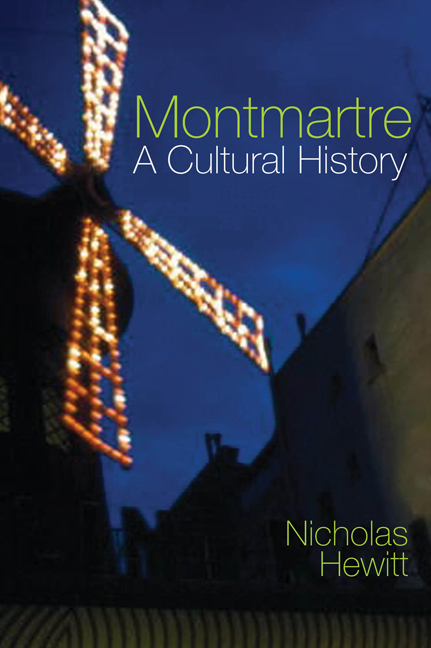Book contents
- Frontmatter
- Dedication
- Contents
- List of Illustrations
- Acknowledgements
- Map
- Introduction
- 1 ‘Montons à la Barrière’
- 2 The Artistic Cabarets
- 3 Music Halls and Mass Culture
- 4 Theatre and the Avant-Garde
- 5 The Bateau-Lavoir and the Lapin Agile
- 6 Wartime and the Années Folles
- 7 The Place of Memory
- 8 The Ecole de Montmartre
- 9 The Occupation: Céline and Aymé
- Epilogue: Montmartre on Film
- Bibliography
- Index
- Plate section
7 - The Place of Memory
- Frontmatter
- Dedication
- Contents
- List of Illustrations
- Acknowledgements
- Map
- Introduction
- 1 ‘Montons à la Barrière’
- 2 The Artistic Cabarets
- 3 Music Halls and Mass Culture
- 4 Theatre and the Avant-Garde
- 5 The Bateau-Lavoir and the Lapin Agile
- 6 Wartime and the Années Folles
- 7 The Place of Memory
- 8 The Ecole de Montmartre
- 9 The Occupation: Céline and Aymé
- Epilogue: Montmartre on Film
- Bibliography
- Index
- Plate section
Summary
The response of the inhabitants of the Butte to the dual threat posed by modernisation and tourism was typically ambiguous, involving an apparently robust assertion of isolation combined with an astute commercial sense. In a tradition going back to Salis and his election campaigns, it took the form of spoof political entities: the ‘Commune Libre de Montmartre’ and the ‘République de Montmartre’, which both combined a serious purpose with fumisme. At the same time, it betrayed an acute wariness of the post-war world, which translated into both a retreat into nostalgia and a continued technical innovation most clearly represented by a flowering of caricature and illustration.
The Commune Libre and the République
The Commune Libre de Montmartre was founded on 11 April 1920 by Jules Depaquit, Maurice Hallé and Roger Toziny. Its first elections, held the same year, involved three competing lists: the Liste antigrattecieliste (‘anti-skyscrapers’), led by Depaquit himself; the Liste sauvagiste, whose manifesto included a proposal for ‘the transformation of the Sacré-Coeur into a municipal swimming pool’; and, significantly, a Liste dadaïste. Depaquit won and was elected maire, Hallé and Toziny serving as his two adjoints. To be sure, as Georges Charensol reminds us, these activities were by no means commercially disinterested: describing the municipality's conception, he comments: ‘Some amiable drunkards and clever café proprietors had the idea of making Montmartre into a Commune Libre’, and the Commune Libre certainly bore witness to a continuation of traditional Montmartre cabaret activity. Paul Yaki is right to characterise it as a ‘joke municipality’ and, indeed, much of its activity took the form of elaborate practical jokes and bogus organisations, like the Alpinistes de la Butte, which go back to a tradition of Montmartre humour of the Belle Epoque. In fact, the Commune's founders come precisely from the tradition of the Montmartre cabarets. Toziny, who came to Montmartre in 1903 as a singer and songwriter, founded the journal La Vache enragée in 1917 with Maurice Hallé, Bernard Lecache and Jack Mercereau, and opened the cabaret of the same name in 1920. Moreover, he was clearly heavily influenced by Willette, often performing dressed as Pierrot and writing Pierrot poems, such as ‘Pierrot pleure’ (1918).
- Type
- Chapter
- Information
- MontmartreA Cultural History, pp. 170 - 202Publisher: Liverpool University PressPrint publication year: 2017



